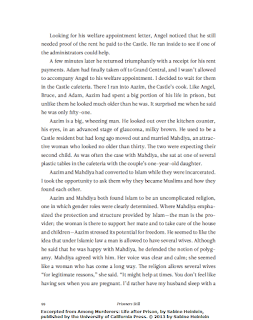 America, Wonder: From Emotion to Spirituality, and Spirituality in the Flesh: Bodily Sources of Religious Experience.
America, Wonder: From Emotion to Spirituality, and Spirituality in the Flesh: Bodily Sources of Religious Experience.Fuller applied the “Page 99 Test” to his new book, The Body of Faith: A Biological History of Religion in America, and reported the following:
Even the best rules have exceptions. Page 99 of The Body of Faith reads like most any history of American religion. It tells about the cultural background of John Muir’s career as a proponent of unchurched spirituality. Indeed, The Body of Faith does chronicle some of the social and cultural factors influencing Americans’ religious life. But this is not its provocative contribution to understanding why humans think or behave religiously as they do. It is a biological history of religion in America. Its focus is the biological body’s role in shaping religiosity.Learn more about The Body of Faith at the University of Chicago Press website.
Many of us were taught to think of humans as blank slates awaiting the outer environment to etch our particular personalities. There is one little problem with this view, however. It isn’t true. We are born with a host of genetically evolved systems that provide particular dispositions toward how we will think, feel, or behave. Biological factors typically account for between 15 and 50 percent of the variance in different human attributes. It is thus important to remember that the environment is ordinarily the most important factor in explaining something as complex as religion. Yet for too long historians have neglected the biological sources of religion. This book hopes to enrich the way we go about understanding the varieties of American spirituality.
Jeffrey Kripal of Rice University offers a succinct summary of what I tried to accomplish: “What would a history of American religion look like if it were grounded in a shared human biology, in the genetics, hormones, sexual organs, bilateral structures, and sensorium of the human body? This is precisely what Robert C. Fuller gives us in The Body of Faith. I was deeply inspired and moved by it.”
The body is replete with sensory mechanisms that fund human experience. We vary in our sensory predispositions and this variance helps us understand why some of us become religious liberals and others of us become religious conservatives. Bodily postures such as kneeling, diverting our gaze, or swaying in a choir all activate sensori-motor systems that shape our basic understanding of the forces upon which we are dependent. Sexual desires motivate us to seek union with an “admired other,” providing the somatic substrates of spiritual devotion to gods and goddesses. Altering the brain’s neurochemistry through ecstatic dance or intoxicating substances produces sensations of ecstasy and transcendence. Attention to these and other biological phenomena enrich and complicate what we thought we knew about such recurring themes in American religion as revivalism, apocalypticism, spiritual seeking, and sectarian formation.
Readers beware. This call for a fully interdisciplinary and naturalistic approach to history will challenge the assumptions of religious believers and secular postmodernists alike.
--Marshal Zeringue
























